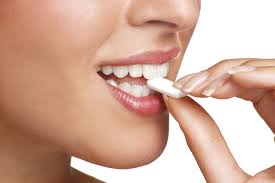
Chewing gum
One of the measures which we can take in order to reduce tooth decay is simply by Chewing chewing gum which helps to protect teeth and gums in between meals when there is no access to paste and brush .
Due to plaque formation in the mouth teeth are more likely to have acid attack after your meal. The acid is produced by plaque bacteria, and the sugars in our food and drink, slowly dissolves the enamel and dentine layer of the tooth, resulting in ‘cavity’ formation and gum disease. Chewing gum helps the mouth to produce more saliva – which is a natural buffer against acid.
More over chewing gum reduces teeth erosion caused by the acidic foods or drinks, such as citrus fruit, fruit juices and fizzy drinks. Some of the minerals in the composition of enamel and dentine are removed making teeth sensitive. Normally It takes the saliva in the mouth about fifty five minutes to replace the minerals that the enamel has lost. But by Chewing chewing gum this is reduced to 20 minutes
Chewing gum and dry moth
Reduced salivary flow results in dry mouth and bad breath . When you chew gum your mouth produces more saliva and the symptoms of dry mouth and bad breath may be reduced.
Sugar free chewing gum
Sugar-free gum do not have any sugar in it. The taste is added using sweeteners like Xylitol which is a natural sweetener. It has a sweetness equal to that of sugar and is found in some berries, fruit, vegetables and mushrooms.
Advice
Although we advice using chewing gum to protect teeth but also we have to keep in mind that we should not chew it for more than 20 minutes this may have a bad effect on our jaw.
Leave a reply →
Leave a reply